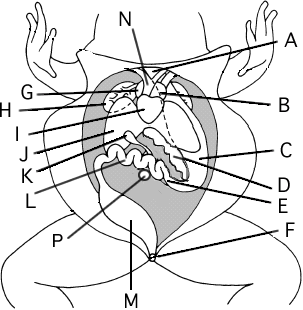Dissection of the Bullfrog - The Digestive System

Examine the liver; it is composed of three lobes. One lobe lies on the right side of the frog. A large left lobe consists of two sub-lobes; verify this by lifting the more ventral sub-lobe and note its basal attachment to the other sub-lobe. The lobes are identified as: right, left anterior, and left posterior. Between the right and left lobe find the sac-like, bile storing gall bladder, greenish in color. The third liver lobe is small and lies dorsal to the gall bladder. Lift the liver lobe and identify the stomach, whitish and roughly J-shaped. Anteriorly the stomach connects to the esophagus. Posteriorly, it connects with the small intestine.
Slit the wall of the stomach and note its contents and the nature of the stomach wall. Carefully pass a blunt probe forward through the stomach and esophagus and into the pharynx.
In the small intestine, the first portion (which is somewhat straighter) is the duodenum. In the section that runs parallel to the stomach you will find the yellowish tissue of the pancreas, and important digestive gland that secretes pancreatic juice into the duodenum. This portion of the small intestine also receives bile from the liver and gall bladder. The bile duct from the gall bladder passes through the tissue of the pancreas where small pancreatic ducts open into the bile duct as well. The duodenum receives both bile and pancreatic juice through the same duct.
Where the small intestine turns posteriorly again, the duodenum ends and the ileum begins. Generally the ileum can be considered the "curly" part of the small intestine, and the duodenum is the straight part just past the stomach. Along the coiled section of the ileum, note the mesenteries, a membrane that holds the coils together. The double membrane carries blood vessels and nerves. Held by mesenteries near the posterior end of the stomach, within the folds of the small intestine, is the reddish (or blue) spleen
It is not actually part of the digestive system, it is part of the circulatory system. Follow the small intestine (ileum) to where it widens: this is the large intestine. The hind portion of this part of the alimentary tract is covered by the urinary bladder, a thin-walled sac that holds urine. The large intestine opens into the cloaca. The word "cloaca" means sewer. Solid and urinary wastes exit the cloaca, as do sperm and eggs. The cloaca and large intestine are not clearly separated. The cloaca opens to the outside of the frog via the anus.
Make a labeled drawing of the digestive system.


